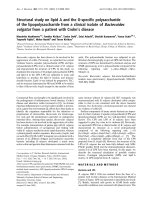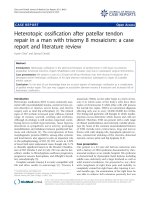Synchronous colonic adenoma and intestinal marginal zone B-cell lymphoma associated with Crohn’s disease: A case report and literature review
Bạn đang xem bản rút gọn của tài liệu. Xem và tải ngay bản đầy đủ của tài liệu tại đây (1.28 MB, 5 trang )
Bennani et al. BMC Cancer
(2019) 19:966
/>
CASE REPORT
Open Access
Synchronous colonic adenoma and
intestinal marginal zone B-cell lymphoma
associated with Crohn’s disease: a case
report and literature review
Amal Bennani1,2*, Ghizlane Kharrasse3, Miry Achraf1, Khanoussi Wafa3, Ismaili Zahi3, Kamaoui Imane4 and
Bouziane Mohamed5
Abstract
Background: Lymphoma and dysplasia are rare complications of long-standing Crohn’s disease. We report an
exceptional case of a synchronous intestinal marginal zone B-cell lymphoma (MALT lymphoma) and colonic
adenoma in a Crohn’s disease patient.
Case presentation: A 50-year-old male patient presented with right lower quadrant for the last 9 months. He also
had associated weight loss and diarrhea alternating with constipation. Ileo-colonoscopy revealed a pseudopolypoid
appearance of the colonic and ileal mucosa with many discontinuous ulcerations with a 3 cm sessile polypoid mass
at 17 cm from the anal verge. Histological examination of the polypoid lesion revealed an adenoma with high
grade dysplasia, while the biopsies of colonic mucosa showed histologic features of Crohn’s disease. Abdominal
computed tomography scan (CT scan) and magnetic resonance imaging (MRI) showed circumferential wall
thickening of the colon and ileum, enlarged mesenteric lymph nodes and a sessile polypoid mass of the
rectosigmoid junction. The patient was scheduled for an ileocoletectomy with resection of the upper rectum and
ileorectostomy.
The histological examination of the resected segment showed histologic features of Crohn’s disease, a rectosigmoid polyp with high grade.
dysplasia and extensive small lymphocytic infiltrate in both colonic and ileal wall which is strongly stained by CD20
and BCL2. The diagnosis of MALT lymphoma with adenoma on a background of Crohn’s disease was made.
The patient successfully completed 8 cycles of Rituximab+ chlorambucil chemotherapy.
Nowadays the patient is asymptomatic without evidence of lymphoproliferative recurrence 10 months after surgery.
Conclusion: We report the first case in the literature of Malt lymphoma with colonic adenoma associated with
Crohn’s disease, and discuss his unique macroscopic and histological features in a patient.
Without immunosuppressive therapy.
Keywords: Lymphomatous polyposis, MALT, Adenoma, Crohn’s disease
* Correspondence:
1
Department of pathology, Mohamed I University, 30050 Oujda, Morocco
2
Laboratory of Epidemiology, Clinical Research and Public, Medical School of
Oujda, Oujda, Morocco
Full list of author information is available at the end of the article
© The Author(s). 2019 Open Access This article is distributed under the terms of the Creative Commons Attribution 4.0
International License ( which permits unrestricted use, distribution, and
reproduction in any medium, provided you give appropriate credit to the original author(s) and the source, provide a link to
the Creative Commons license, and indicate if changes were made. The Creative Commons Public Domain Dedication waiver
( applies to the data made available in this article, unless otherwise stated.
Bennani et al. BMC Cancer
(2019) 19:966
Page 2 of 5
Background
Crohn’s disease is a chronic and idiopathic inflammatory.
disease that has the potential to affect any segment of
the gastrointestinal tract from mouth to anus. It is characterized by patchy involvement with transmural inflammation. Although many studies have suggested that
patients with Crohn’s disease may have an increased risk
of developing lymphoma [1], the relationship between
these entities remain unclear [2]. It is also know that patients with Crohn’s disease have increased risk of colorectal carcinoma and dysplasia [3, 4]. The association of
colonic lymphoma and adenocarcinoma has rarely been
reported in the literature [5], while the coexistence of
precursor lesion (adenoma) and lymphoma has never
been described in the same specimen. We report the
first case in the literature of a synchronous MALT
lymphoma and colonic adenoma with high grade dysplasia in a patient with Crohn’s disease.
Case presentation
In this report, we describe a 50-year-old male patient presented with right lower quadrant for the last 9 months. He
also has had associated weight loss (9 kg) and diarrhea alternating with constipation. He was a former smoker (22
pack-years), and current drinker (1–3 drinks per week).
He had undergone appendicectomy for appendicitis 25
years earlier with no evidence Crohn’s disease on histology. He also had no familial history of inflammatory
bowel disease or cancer.
On examination, he was dehydrated and had no fever.
His pulse rate was 90 beats per minute, blood pressure
110/60 mmHg and respiratory rate 16 cycles per minute.
The abdominal examination showed deep tenderness
in lower right quadrant, without palpable mass or draining fistula.
Fig. 1 T1 coronal section after gadolinium injection showing a
circumferential wall thickening of the colon and the ileum (arrows)
with enlarged mesenteric lymph nodes
Histological examination
The histological examination of the recto-sigmoid polyp
showed a high-grade dysplasia with heavy mononuclear
cell infiltrate suggestive of reactive lymphoid hyperplasia.
Histology from the colonic mucosa showed histologic
features of Crohn’s disease with heavy mononuclear cell infiltrate suggestive of reactive lymphoid hyperplasia, while
ileal biopsies showed a chronic ileitis without granulomas.
Discussion in the multidisciplinary meeting confirmed
the presence of a polypoid high-grade dysplasia in a
Investigations
Laboratory tests at presentation showed an elevated Creactive protein level of 32 mg/L and low albumin of 28
g/L. A complete blood count revealed total leukocytes
4800/mm3 and hemoglobin 10.2 g/dl. Other bloodwork
was unremarkable.
An abdominal CT and abdominal MRI showed a circumferential wall thickening of the colon and the ileum (Fig. 1)
and mesenteric fat infiltration suggestive of Crohn’s disease.
It also presented enlarged mesenteric lymph nodes and a
sessile polypoid mass of the rectosigmoid junction.
Ileo-colonoscopy revealed a 3 cm sessile polypoid mass
at 17 cm from the anal verge (Fig. 2), many ulcerative
and hemorrhagic lesions of the ileum and pseudopolypoid appearance of ileocolonic mucosa.
The polypoid mass, the colonic and ileal mucosa were
biopsied.
Fig. 2 Colonoscopy showed a sessile polypoid mass at 17 cm from
the anal verge
Bennani et al. BMC Cancer
(2019) 19:966
patient with Crohn’s disease. Due to the difficulty of a
complete endoscopic resection and the multifocal nature
of dysplasia in Crohn’s colitis a surgical removal of the
colon was considered more appropriate. Consequently,
the patient underwent an ileocoletectomy with resection
of the upper rectum and ileorectostomy.
Gross examination revealed a surgical specimen measuring 65 cm with a 3.5x2x2 cm polypoid mass at 5 cm
from the surgical margin. Ileocolonic mucosa showed a
multiple sessile polyps of different sizes (2–7 mm), ulcerations and granulations. The last characteristic was only
seeing in the ileum serosa (Fig. 3). Multiple enlarged
mesenteric lymph nodes were also found.
Pathology of the resected ileum revealed large, deep and
discontinuous ulcerations without granuloma; there was also
a diffuse lymphoid infiltrate that had reaches the serosa.
The histological examination of the resected colon
showed an adenoma with high grade dysplasia. Extensive
small lymphocytic infiltrates were noted at the base of
the adenoma (Fig. 4). We also noted 2 areas of low grade
flat dysplasia.
Immunohistochemistry of the lymphocytic infiltrates
showed a strong and diffuse positivity for CD20 (Fig. 5),
and BCL2, while CD3 highlighted some mature T-cells
in the background. The CyclinD1, CD10, CD23 were
negative. The diagnosis of colonic adenoma associated
with MALT lymphoma in a background of Crohn’s disease was made.
Twenty-five lymph nodes were also invaded by the
MALT lymphoma. The patient successfully completed 8
cycles of Rituximab+ chlorambucil chemotherapy.
Nowadays the patient is asymptomatic without evidence of lymphoproliferative recurrence 10 months after
surgery.
Page 3 of 5
Fig. 4 Adenoma with high grade dysplasia, and extensive small
lymphocytic infiltrates at the base of the adenoma (HESx5)
This risk increases exponentially with the duration and extension of the disease [4]. The immediate precursor of
CRC in IBD is dysplasia. In addition to their microscopic
classification (low grade and high grade dysplasia), dysplastic lesions in IBD are also classified endoscopically as
flat or raised also referred to by the acronym as DALM
(dysplasia associated lesion or mass), which are further
classified as resectable (‘adenomalike’) vs. non-resectable
(‘non-adenomalike’) [6]. Endoscopic surveillance at regular
intervals is the reference method for detecting theses lesions and carcinoma at an early stage [3], by using highresolution technique combined with indigo carmine (or
methylene blue) staining.
Discussion and conclusion
It is well known that patients with colonic Crohn’s disease have a high risk of developing colorectal cancer.
Fig. 3 Surgical specimen: before formalin fixation showing
numerous sessile polyps of varying sizes of the intestinal mucosa
(white asterisk) with some ulcerations and whitish granulations in
the ileum serosa (black asterisk)
Fig. 5 The small lymphocytes are strongly stained with CD 20
Bennani et al. BMC Cancer
(2019) 19:966
Patients with Crohn’s disease are also at increased risk
of developing lymphoma. This association has been reported in many case reports. In 60% of these cases
lymphoma in Crohn’s disease was localized in the small
or large bowel and in 40% it was extra intestinal [7].
Although most of studies suggested that the use of immunosuppressive drugs, like infliximab, azathioprine,
and 6-mercaptopurine, may increase this risk, many
other studies reported patients who developed lymphoma without any immunosuppressive therapy other than
corticosteroids [8–10]. This finding suggests that the increased risk could be only associated with the severity of
the disease.
The occurrence of a lymphoma in Crohn’s disease patients can be explained by deregulated interactions between the immune system and the luminal bacteria
which are implicated in the pathogenesis of Crohn’s disease [1]. It can also be related to chronic inflammatory
per se, since it may lead to an in situ genesis of lymphoma in other contexts [11] . Since the discovery of new
types of Th1 cells such as Treg, Th3, and Th17, as well
as the application of antibodies to inflammatory factors
TNF-α, IL-12, IL-22, and other new cytokines, it is clear
that Crohn’s disease is a complex disease, with different
mechanisms in different periods of disease progression,
which is why the use of IL-12 or TNF-α antibody treatment in many patients with Crohn’s disease is not so effective [12].
Our case presents a possible insight into the interrelationship of Crohn’s disease and the immune system as
seen with the coexistence of precursor lesion and
lymphoma.
Several subtypes of lymphoma have been described in
patients with Crohn’s disease: Hodgkin’s lymphoma, follicular lymphoma, non-Hodgkin’s (low grade lymphoma)
[13], anaplastic large cell lymphoma [14], Hepatosplenic
T-cell lymphoma [15], EBV-associated plasmablastic
lymphoma [16], with only two cases of MALT lymphoma [13, 17].
MALT lymphoma is an extranodal lymphoma characterized by heterogenous small B-cells proliferation [18].
Stomach is the commonest site, while Colonic MALT
lymphomas are exceedingly rare. In the current case, MALT
lymphoma had a unique and rare presentation as multiple
lymphomatous polyposis. Such polypoidal lesions can’t be
differentiated from adenomatous or hamartomatous polyposis by colonoscopy alone. The histological examination
with immunohistochemical study is mandatory.
We herein report an exceptional case of dual intestinal
lymphoma and dysplasia associated with Crohn’s disease.
Synchronous adenocarcinoma and lymphoma in patient with
Crohn’s disease has rarely been documented [5]. However,
we didn’t find any paper about the coexistence of precursors
lesions and lymphoma in a patient with Crohn’s disease.
Page 4 of 5
This case may be the first in the literature describing
this rare association between a precursor lesions and a
primary MALT intestinal lymphoma in the same surgical specimen.
Clinicopathological presence in multidisciplinary meetings to discuss such difficult cases is mandatory to reach
the appropriate management.
Abbreviations
CT: Computed tomography; HES: Hematoxylin eosin safran; MALT: Mucosaassociated lymphoid tissue; MRI: Magnetic resonance imaging
Acknowledgements
Not applicable.
Authors’ contributions
AB and AM performed the histological examination of the tumor and were
major contributors to writing the manuscript. KG, KW and IZ analyzed and
interpreted the patient data. IK interpreted the radiological data and BM
performed surgical resection. All authors read and approved the final
manuscript.
Funding
Not applicable
Availability of data and materials
All the original data supporting our research are described in the Case
presentation section and in the figures’ legends.
Ethics approval and consent to participate
Not applicable
Consent for publication
Written informed consent was obtained from the patient for publication of
this case report and any accompanying images. A copy of the written
consent is available for review by the Editor-in-Chief of this journal.
Competing interests
The authors declare that they have no competing interests.
Author details
1
Department of pathology, Mohamed I University, 30050 Oujda, Morocco.
2
Laboratory of Epidemiology, Clinical Research and Public, Medical School of
Oujda, Oujda, Morocco. 3Department of Gastroenterology, Mohamed I
University, 30050 Oujda, Morocco. 4Department of radiology, Mohamed I
University, 30050 Oujda, Morocco. 5Department of Surgical Oncology,
Mohamed I University, 30050 Oujda, Morocco.
Received: 11 June 2018 Accepted: 9 October 2019
References
1. Koronakis N, et al. Mesentery lymphoma in a patient with Crohn's disease:
an extremely rare entity. Int J Surg Case Rep. 2012;3(7):343–5.
2. Binder V. Clinical epidemiology—how important now? Gut. 2005;54(5):574–5.
3. Kiran RP, et al. Dysplasia associated with Crohn's colitis: segmental
colectomy or more extended resection? Ann Surg. 2012;256(2):221–6.
4. Matkowskyj KA, et al. Dysplastic lesions in inflammatory bowel disease:
molecular pathogenesis to morphology. Arch Pathol Lab Med. 2013;
137(3):338–50.
5. Bell RDB, Moriarty KJ. Synchronous colonic lymphoma and adenocarcinoma
in a patient with Crohn's disease, treated with thiopurine therapy and a
TNFα inhibitor: a challenge to Occam's razor. BMJ Case Rep. 2016;2016:
bcr2015212464.
6. Harpaz N, Ward SC, et al. Precancerous lesions in inflammatory bowel
disease. Best Pract Res Clin Gastroenterol. 2013;27(2):257–67.
7. von Roon AC, et al. The risk of cancer in patients with Crohn’s disease. Dis
Colon Rectum. 2007;50(6):839–55.
Bennani et al. BMC Cancer
8.
9.
10.
11.
12.
13.
14.
15.
16.
17.
18.
(2019) 19:966
Lewis JD, et al. Inflammatory bowel disease is not associated with an
increased risk of lymphoma. Gastroenterology. 2001;121(5):1080–7.
Bernstein CN, et al. Cancer risk in patients with inflammatory bowel disease.
Cancer. 2001;91(4):854–62.
Beaugerie L, Brousse N, Bouvier AM, et al. Lymphoproliferative disorders in
patients receiving thiopurines for infl ammatory bowel disease: a
prospective observational cohort study. Lancet. 2009;374(9701):1617–25.
Beaugerie L, Sokol H, Seksik P. Noncolorectal malignancies in inflammatory
bowel disease: more than meets the eye. Dig Dis. 2009;27(3):375–81.
Li N, Shi R-H. Updated review on immune factors in pathogenesis of
Crohn’s disease. World J Gastroenterol. 2018 Jan 7;24(1):15–22.
Fraser A, et al. Long-term risk of malignancy after treatment of inflammatory
bowel disease with azathioprine. Aliment Pharmacol Ther. 2002;16(7):1225–32.
Shukla T, et al. Anaplastic large cell lymphoma of the colon in a patient
with colonic Crohn disease treated with infliximab and methotrexate. Can J
Gastroenterol Hepatol. 2014;28(1):11–2.
Thai A, Prindiville T. Hepatosplenic T-cell lymphoma and inflammatory
bowel disease. J Crohn's Colitis. 2010;4(5):511–22.
Liu L, Charabaty A, Ozdemirli M. EBV-associated plasmablastic lymphoma in
a patient with Crohn's disease after adalimumab treatment. J Crohn's Colitis.
2013;7(3):e118–9.
García-Sánchez M, et al. MALT lymphoma in a patient with Crohn's disease.
A causal or incidental association? Gastroenterol Hepatol. 2006;29(2):74–6.
Palo S, Biligi DS. A unique presentation of primary intestinal MALT
lymphoma as multiple Lymphomatous polyposis. J Clin Diagn Res. 2016;
10(4):ED16.
Publisher’s Note
Springer Nature remains neutral with regard to jurisdictional claims in
published maps and institutional affiliations.
Page 5 of 5









